Human papillomavirus (HPV) affects epithelial cells and has a particle diameter of 55 nm. A characteristic feature is the proliferation of skin epithelium, as well as mucous membranes. In the early stages, pathogens usually affect the basal cells of the epithelium, penetrating into them through microtraumas. Localized papillomas are usually found on the skin of the neck, armpits, groin and genitals (most often), oral mucosa and nasopharynx.
The virus can exist for years without symptoms. To detect HPV, electron microscopic methods or molecular hybridization are used.
Types of human papillomavirus
In humans, there is HPV, which affects the mucous membranes and skin. Among the large number of papillomaviruses, species with low and high oncogenic risk are distinguished. It has been proven that oncogenic properties are associated with the ability to integrate DNA into the genome of human cells.
The virus is activated in 10-20% of cases. Depending on the type, it can cause benign or malignant lesions. Some HPVs are not oncogenic. They lead to the appearance of genital warts and warts. The most common are HPV 6 and 11.
HPV oncogenes are those who have a high risk of getting cancerous lesions, especially on the cervix or anus. For the skin, HPV 16 and 18, as well as 5 and 8, which can cause skin cancer, are more common. The most well-known form of cancer caused by HPV is cervical cancer. But men can also be infected with the papilloma virus, which in the worst cases causes cancer of the penis or anus.
Most often women encounter HPV 16 - this is a form in which introsomal parasitism is observed, that is, outside the cell chromosome (benign). HPV 18 has a high risk of getting cancer - benign tumors form first, which after some time degenerate into cancer. Virions in this case have a small size (up to 30 nm).
- cervical neoplasm;
- invasive or pre-invasive oncology;
- genital warts on the urinary tract and genitals.
Characteristics of infection

Human papillomavirus is highly contagious. It is usually transmitted through direct contact, skin to skin or mucous membrane to mucous membrane, with an infected person. For genital infections, this most often occurs during vaginal or oral sex. Having multiple sexual partners or other STIs (sexually transmitted infections) increases the risk. Indirect transmission through contaminated objects, clothing or bedding is also possible but relatively rare.
In 7% of cases, transmission of the virus from mother to child can occur during childbirth, when the infection is active. The risk increases to 40% if infected with HPV 16 or 18.

By penetrating the epithelium, violating its integrity, papillomavirus infection promotes the growth of the lower layer of epithelial cells in the form of condyloma or warts. This form of the disease is contagious and quickly spreads to others. As a rule, warts and condylomas do not cause metastasis and often disappear spontaneously.
HPV symptoms
The incubation period lasts up to 9 months (average 3 months). HPV can be present in the body without obvious symptoms. The virus can go undetected for months or years. Even at this stage it is contagious.
Skin warts usually occur in groups and increase in number when scratched. The two most common forms of papilloma are either gray, hard, raised with a broken surface (common warts) or flat and reddish (flat warts). Spiny warts occur on the soles of the feet or heels, grow inward and are therefore often painful.
- Genital warts. Pale or reddish nodules that often appear in groups and occur on the labia, vagina, penis, urethra, anus, and rectum. They are highly contagious.
- Flat condyloma. They appear in the form of flat nodes and are found mainly on the female genital organs. They increase the risk of getting cancer.
- Giant condyloma (Buschke-Levenshtein tumor). They grow into large formations, destroying the surrounding tissue. In rare cases, they can degenerate and lead to squamous cell carcinoma.
Infection of the mucous membranes in the upper respiratory tract is also possible. The conjunctiva of the eye may be affected, resulting in the growth of pink stalks.
It is more difficult to detect an asymptomatic course, which can only be seen by a doctor with the help of additional means such as acetic acid (causes the wart to change color) or a microscope.
In addition, the virus can also reside in cells without any tissue changes. Then they talk about latent infection, that is, the presence of pathogens, but without symptoms. Once infected, this phase can last from several weeks to several months.
Possible consequences
When infected, the virus penetrates the cells of the integumentary tissue of the skin and mucous membrane, settles in the nucleus of the cellular structure and reproduces there. Usually, such HPV infections go unnoticed and heal on their own without consequences, because the immune system successfully fights the pathogen.
However, some types of HPV create skin changes called growths. Possible forms include genital warts or condylomas and papillomas, which can affect, for example, the face, arms or legs.
The resulting tissue changes are mostly harmless, but can also degenerate and lead to cancer. For example, cancer can occur decades after an HPV infection. Cancer of the female external genitalia (cancer of the vulva and vagina), cancer of the anus, cancer of the penis, and cancer of the mouth and throat (tumors of the head and neck) are also possible.
Establish a diagnosis

Tests for HPV infection are carried out in women as part of a preventive visit to a gynecologist. During a gynecological examination, a smear is taken from the lining of the cervix, this is called a Papanicolaou test (cytological examination). The resulting material is studied for tissue changes to determine precancerous conditions.
In addition, an HPV test can be performed, where cellular material from a mucosal swab or tissue sample is tested in the laboratory for the presence of a specific virus. However, this only proves that the affected area is infected, but does not make any statement as to whether tissue changes have occurred. Therefore, HPV testing makes sense, especially when combined with a Pap test, and can help detect cancer precursors at an early stage.
If the test is positive, there is no reason to worry because the infection does not always lead to cancer. Regular examinations are recommended to detect tissue changes at an early stage. On the other hand, a negative test result does not indicate whether there is a past infection that the body has successfully fought off.
For men, there is no preventive check-up where tests will be carried out periodically. If an underlying cancer is present, tumor testing can determine whether HPV infection is underlying the cancer.
Specific DNA methods are also used in laboratory diagnostics, such as real-time PCR. Anogenital warts caused by HPV types 6 and 11 are easily detected during a gynecological examination.
How to cure human papillomavirus
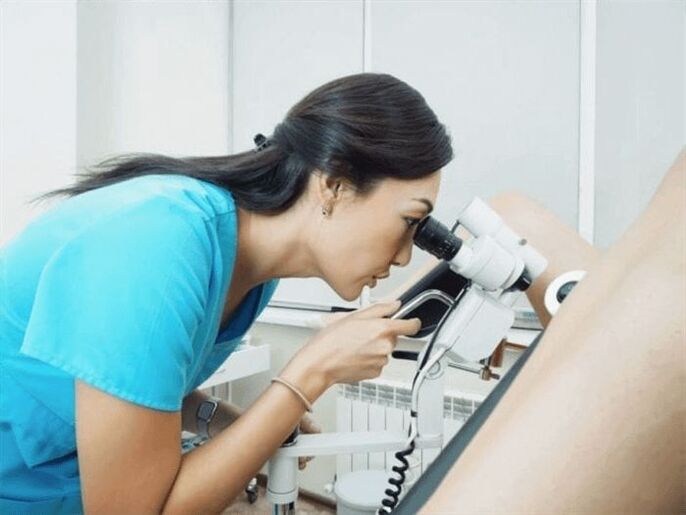
In most cases, the disease does not require treatment because it disappears on its own and then the virus is no longer detected. However, if this does not happen, the infection may last longer and persist for months or years.
Until now, there is no method of systemic influence against this virus that can completely destroy it. However, treating existing warts reduces the number of viruses, so in many cases the immune system can fight the remaining viruses and thus get rid of them. In some cases, the pathogen persists and can cause symptoms of the disease repeatedly.
- Plantar and genital warts can be treated with medications formulated with salicylic acid for topical use.
- Cryotherapy is also a method often used for HPV. In this case, the warts are burned with cold, using liquid nitrogen.
- Laser or electrocautery is the same method used.
For cancers caused by HPV, treatment is more difficult. For cervical cancer, it is often advised to remove the uterus, the upper part of the vagina and the ovaries, respectively. This can be supplemented with radiation therapy to eliminate the possibility of recurrence. Other cancers caused by HPV are most often treated with targeted therapy, such as radiation or chemotherapy.
It should be remembered that the operation is not a radical solution, but only solves a cosmetic problem, because after removal the virus can remain in the surrounding tissue and the condyloma can reappear.
Infection prevention
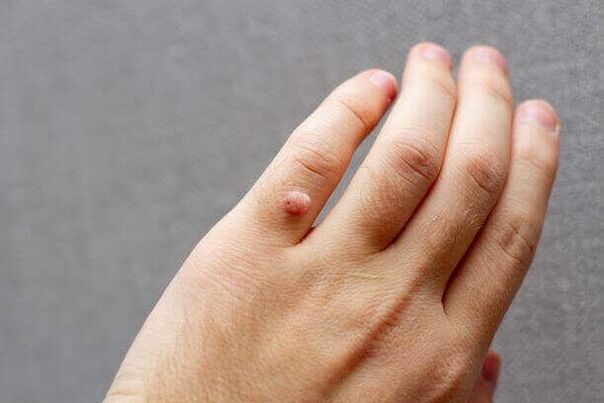
There are two vaccinations: the bivalent vaccine against HPV 16 and 18 and the quadrivalent vaccine against HPV 6, 11, 16 and 18. Vaccination is recommended for all young girls aged 14 and over.
Vaccination does not protect against all types of HPV. Therefore, all women aged 25 to 65 years, even if they have been vaccinated, are advised to undergo regular smear examinations.
Timely detection and complete removal of condyloma reduces the risk of disease. The effectiveness of condom use to protect against transmission of infection can significantly reduce the risk of this disease. The most promising way to prevent and treat the early stages of the disease caused by this infection is a specific polyvalent vaccine.
Why plantar warts appear and treatment methods
Warts are skin lesions that appear in the form of characteristic round formations that protrude above the surface. They arise because of certain viruses.
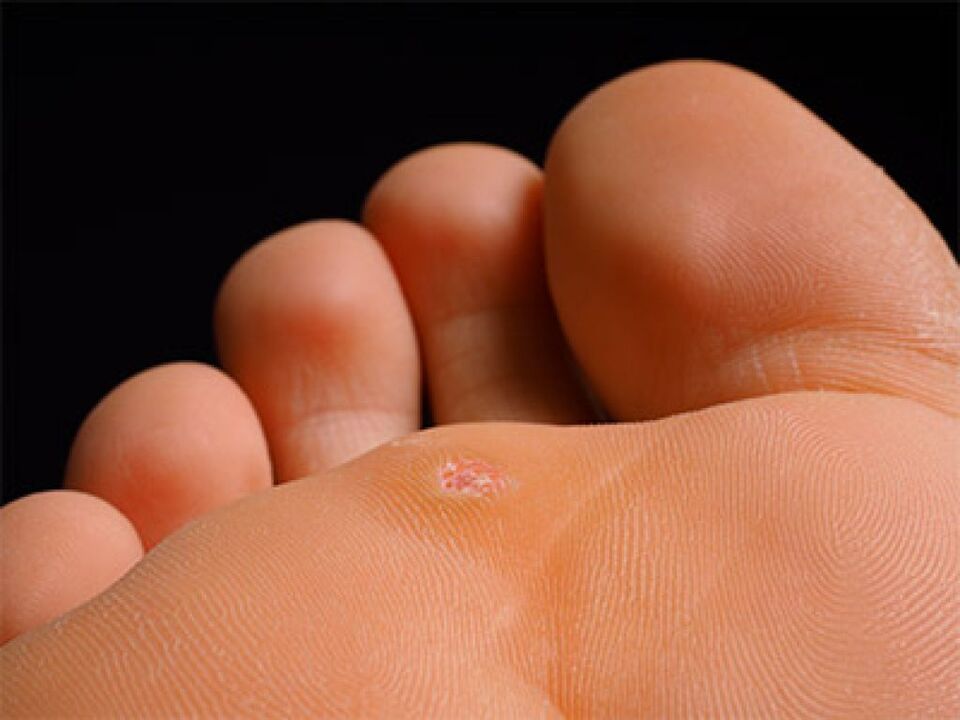
These formations often cause physical discomfort due to their location. Even after treatment they tend to recur.
Types and causes
There are many types of warts; they are classified according to several characteristics:
- Easy. It occurs on exposed parts of the body, arms, legs, face, and scalp. It is usually harmless, but it is not aesthetically pleasing and can multiply quickly, affecting large areas of skin. They are arranged as if in a "family".
- Plantar. Their localization is exclusively on the legs. Causes discomfort when walking.
The main cause is infection with the human papillomavirus, which affects the mucous membranes and skin.
Human papillomavirus
This is one of the most common viruses on Earth. Infection can occur in several ways:
- relationships and households (through touch);
- sexual (genital, anal, oral-genital);
- during childbirth from mother to child.
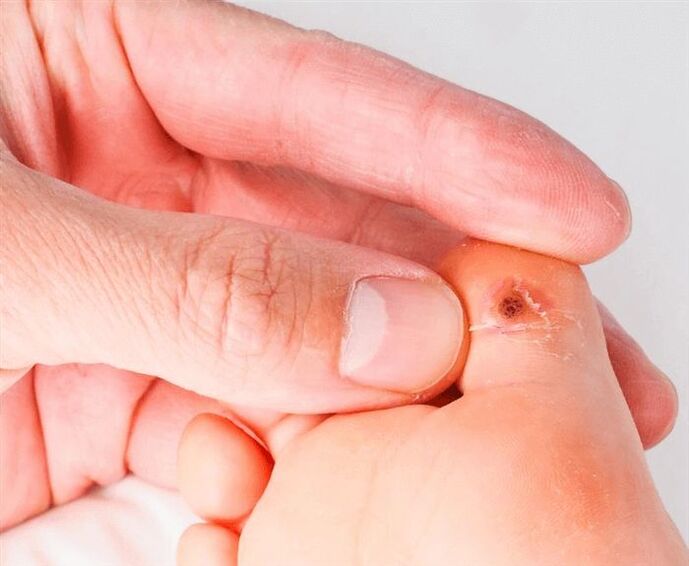
The duration of the development of the disease ranges from several weeks to decades, this is explained by the fact that the virus may not manifest itself for a long time, but as soon as the immunity is slightly weakened, growths immediately appear on the skin and/or mucous membranes. The main danger of this disease is that certain types of HPV are more likely to cause the formation of malignant tumors (skin or mucous membrane cancer). To ensure that the disease will not lead to the formation of tumors, it is necessary to undergo an examination by a doctor and not self-medication.
Symptoms and types of warts on the legs
Plantar warts appear as a callus-like thickening of the stratum corneum layer of the skin. It interferes with walking and causes pain. The passive state is characterized by slow reproduction, does not reach the stratum corneum epithelium, so this state is not manifested externally.
The active state is characterized by the fact that the virus grows rapidly and, rising to the upper layers of the epidermis, manifests itself in various symptoms. Plantar warts are also called spinous warts, chicken warts. The virus enters during skin contact through cuts and abrasions on the outer layer of the skin:
- First, small yellowish-gray papules with an uneven surface appear.
- Gradually, small elements become dense and acquire a dirty color.
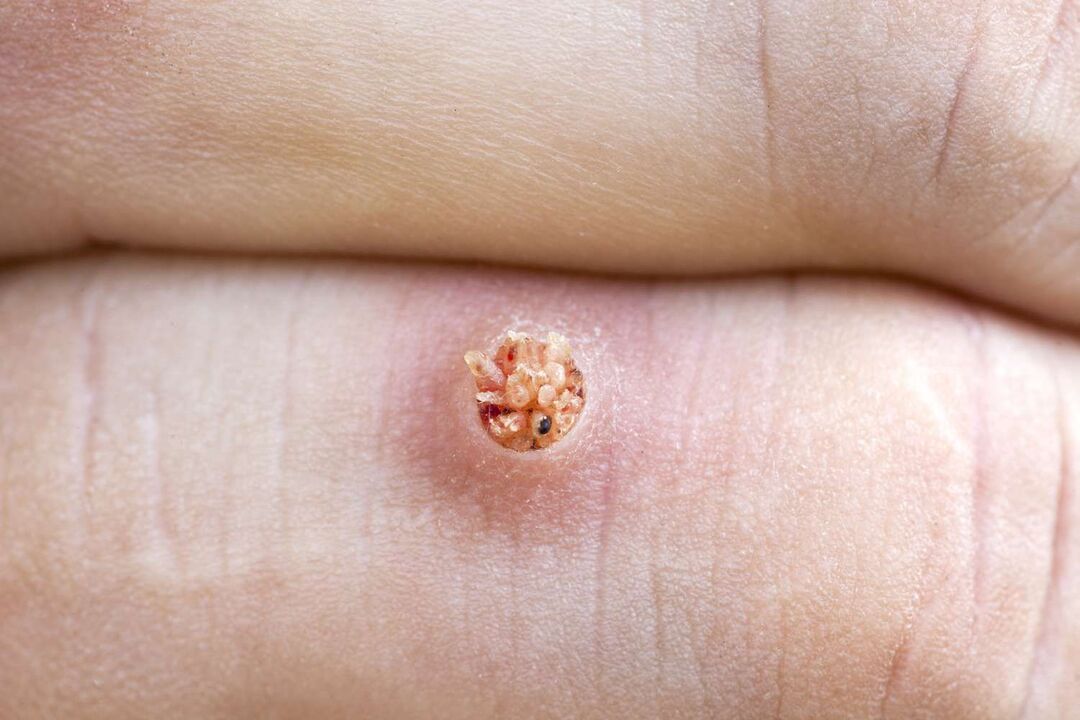
From the inside, plantar warts look like fused papillae of different sizes with a pink color. Extra capillaries form there, causing bleeding if you hit a wart.
Removal of plantar warts
It is worth treating plantar warts if:
- There is a painful sensation.
- Bleeding warts.
- There are spots on it.
- Warts quickly increase in size.
There are many treatment methods. One of them is cryodestruction. The meaning of the method is that warts are exposed to liquid nitrogen at a temperature of minus 196 degrees. The area affected by the virus is frozen and the wart is removed.
Common and aggressive exposure methods are used. With aggressive methods, nitrogen is used for a few seconds longer, but this method is more painful. It is important to note that if warts appear and exist for more than six months, then the effectiveness of cryodestruction is greatly reduced, and the meaning of such an operation, therefore, is also lost.
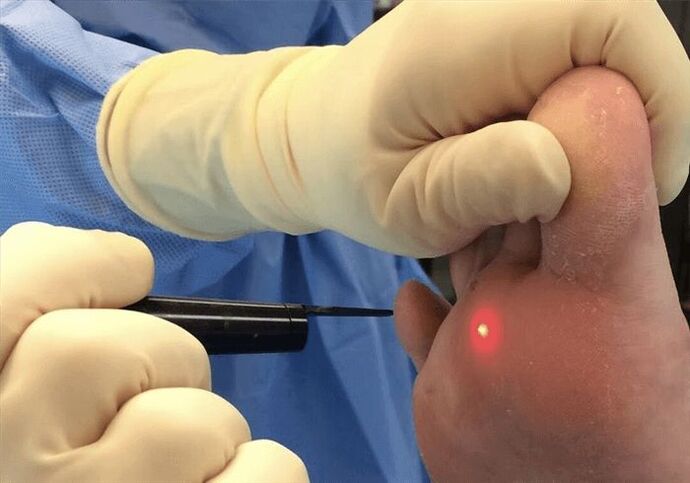
After removing plantar warts using liquid nitrogen, you should follow some recommendations:
- the blister that remains at the site of the wart cannot be opened;
- to avoid mechanical damage, use a sterile bandage instead of a plaster;
- Treat the affected area with 2% salicylic alcohol twice a day;
- try to prevent water from entering the affected area.
Another method is laser freezing. This is one of the most common ways to get rid of warts. Most laser systems are equipped with a special cooling system. Therefore, the procedure occurs with minimal discomfort and does not allow inflammation, because the laser has antiseptic properties. Moreover, this is a non-relational method.
There are several ways:
- Carbon dioxide (CO2) laser. Treatment in this case occurs using infrared light. This method is 70% effective, but the downside is that healthy tissue can also be damaged.
- Erbium laser. This treatment method uses shorter wavelengths, which reduces the possibility of scarring after surgery. Efficiency is usually 75%.
- Pulsed dye laser. With this method of exposure, the primary destruction of capillaries is expanded in warts and stimulation of the immune system, which contributes to effective healing. Treatment effectiveness is about 95%.
After laser treatment, a crust forms on the affected area, which disappears on its own within seven to ten days. Recommendations for this treatment method are the same as after exposure to nitrogen - avoid mechanical damage and water ingress.
The next way to get rid of warts is electrocoagulation. In this case, a high-frequency current is applied to the wart. Treatment is carried out under local anesthesia. Exposure of warts to high temperatures leads to the evaporation of cells affected by the papilloma virus. Another advantage of this method is that cauterization of blood vessels prevents bleeding. After surgery, a crust forms on the affected skin area, which disappears within 7 to 10 days.
Plantar warts can be treated with direct surgery. In this case, the excision takes place under local anesthesia, then sutures are used. After the operation, the doctor will prescribe certain recommendations. Therefore, it is recommended to prevent water and soap from entering the affected area, not to tear off the resulting crust, and to treat the affected area with an antiseptic in the first 7-10 days.
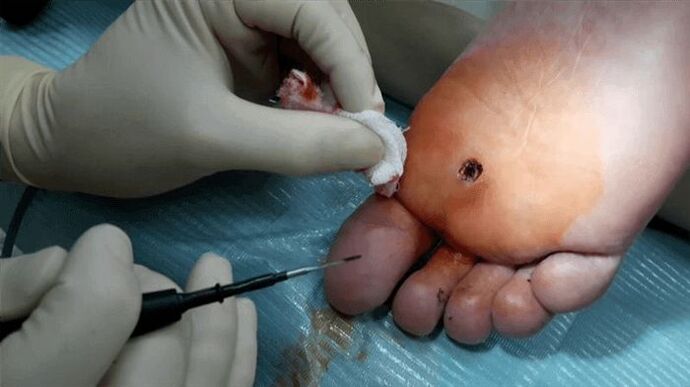
For each type of operation there are certain contraindications. Therefore, it is impossible to perform the operation if the following occurs:
- pregnancy;
- diabetes;
- malignant tumors in the body;
- infection and inflammation around the wart;
- exacerbation of herpes;
- high temperature.
If your blood pressure is high, the procedure should also be delayed.
Wart treatment without surgery
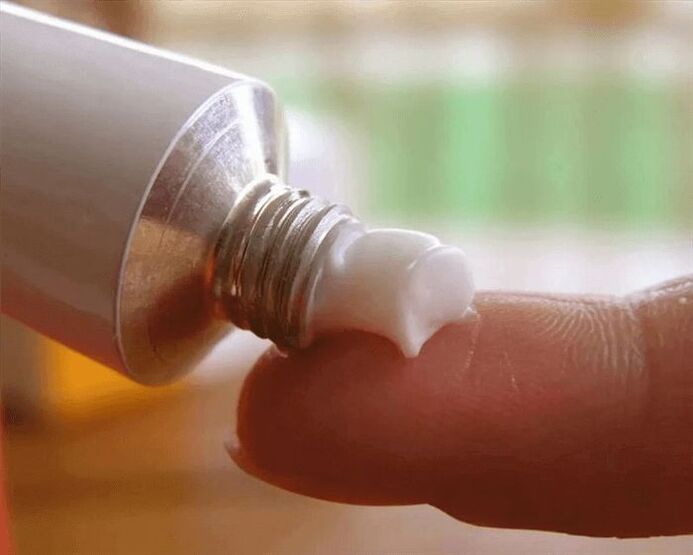
People often wonder how to remove plantar warts without surgery. To do this, you can use pharmaceutical ointments and solutions.
Basically, this ointment has the following effects:
- anti-inflammatory;
- antiseptic;
- immunomodulators;
- antivirus;
- antifungal.
In addition, it may contain vitamin E, which also has a positive effect on treatment, because vitamins generally strengthen the body and reduce the risk of relapse.
It is important that this product should be used for single and superficial plantar warts. Moreover, if any side effects occur, it is necessary to wash the medicine with plenty of warm water and immediately seek help from a doctor.
So, it is possible to cure warts, there are many ways to do this, but you cannot do this without first consulting a doctor, so as not to harm your health. In addition, it is strictly forbidden to self-medicate if the attending physician prescribes contraindications.
Treatment of papilloma on the body
Hardware method
Modern hardware methods for treating papillomas make it possible to get rid of them and prevent the development of disease recurrence. The most commonly used methods are:
- Cryodestruction is the destruction of growth by exposing it to low temperatures.
- Electrocoagulation is cauterization of the formation with electric current, the strength and frequency of which is selected depending on the size, type and density of the papilloma.
- Laser removal. The type of impact is obvious from the name. This procedure takes no more than 15 minutes and helps to get rid of unpleasant growths forever.
Drug treatment
Among the medicines used are celandine, castor oil, lapis pencil, Sani Skin and Dermavit preparations.
They show variable efficacy and do not prevent disease recurrence. The main disadvantage of drug therapy for papilloma is the frequent development of allergic reactions.
Prevention of papillomas
To prevent the appearance of tumors and avoid infection with human papillomavirus, you should:
- Use barrier contraception during sexual intercourse.
- Follow the rules of personal hygiene and use only individual towels, soap and toothbrushes.
- When visiting a public bath, don't forget to wear rubber shoes.
You should also normalize your daily routine, eat a balanced diet, abandon bad habits and avoid stressful situations. These factors are not the cause of the disease, but can trigger its development if the virus is already present in the body.















































































